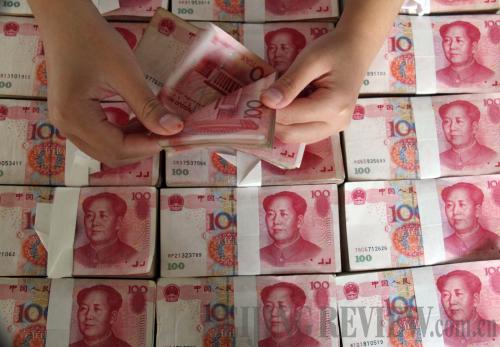|
 |
|
USING THE YUAN: China is accelerating the process of internationalizing its currency (ZHANG CHUNLEI) |
Demand for the renminbi in Hong Kong has led several senior officials, including Financial Secretary John Tsang Chun-wah, Secretary for Financial Services and the Treasury K.C. Chan and Hong Kong Monetary Authority (HKMA) Chief Executive Norman T.L. Chan, to pay a visit to Beijing on October 29, asking the China Securities Regulatory Commission (CSRC) for support and exchanging views with CSRC Chairman Guo Shuqing.
A senior CSRC official disclosed on November 2 that upon request of the government of the Hong Kong Special Administrative Region, the CSRC is planning to further enlarge the investment quota for renminbi qualified foreign institutional investors (RQFII) by coordinating with the People's Bank of China (PBC) and the State Administration of Foreign Exchange (SAFE).
Hong Kong appealed for another RQFII investment quota of 100 billion-200 billion yuan ($15.9 billion-31.8 billion), which has been supported by the CSRC. On November 13 the CSRC, PBC and SAFE agreed to increase the RQFII quota by 200 billion yuan ($32.12 billion).
Besides raising the investment quota, the commission will also consider further improving the RQFII system by expanding its investment scope and relaxing investment restrictions so as to allow more Hong Kong financial institutions to apply for the RQFII.
Industrial insiders think expanding the RQFII investment quota and relaxing application qualifications will undoubtedly accelerate the capital account convertibility of the renminbi and promote the process of its internationalization.
Hong Kong is the world's largest renminbi offshore center, and the source of most of the present RQFII capital. According to figures from HKMA, renminbi deposits in Hong Kong had reached 550 billion yuan ($87.44 billion) by the end of September. It is expected that as the renminbi is more internationalized, the amount of RQFII capital will increase steadily.
This is the third and largest expansion of the RQFII.
The CSRC and SAFE jointly launched the RQFII system at the end of 2011 with an initial quota of 20 billion yuan ($3.18 billion). Qualified fund management companies and securities companies are allowed to issue renminbi-denominated funds and invest them into the mainland capital market.
Most of the first batch of RQFII products were launched at the end of March and were mainly invested into the bond market. Benefiting from relaxed money supplies and narrowing interest difference in the mainland market, these RQFII products have performed well.
Public figures from Hong Kong show that the average growth rate for the net value of the first batch of RQFII products is 1.2 percent.
China raised the quota by 50 billion yuan ($7.95 billion) in April, capping it at 70 billion yuan ($11.13 billion).
Different from the first batch, the newly increased quota can be used to develop Exchange Traded Funds (ETFs) that are invested in the stock index of the A-share market. The decision was widely welcomed for satisfying the demand of institutional investors to track the performance of stocks in the mainland market.
In July, the ChinaAMC CSI 300 Index ETF, which China Asset Management (Hong Kong) Limited (CAMHK) listed, was in high demand upon its availability on July 17. Later debuted RQFII products, such as CSOP A50 ETF, EFUND CSI100 ETF and HGI MSCI CN A, were also highly sought after.
The approved quotas for the CSOP A50 ETF and the EFUND CSI100 ETF are 5 billion yuan ($794.91 million) and 2 billion yuan ($317.97 million) respectively. Since the capital raised during their initial public offerings had already reached the upper limit, both funds closed for purchase after their debut.
On August 29, the SAFE raised the quota by 3 billion yuan ($46.95 million) for the EFUND CSI100 ETF, helping it open for purchase. On September 7, the CSOP A50 ETF also saw its quota rise by 2 billion yuan, which was soon digested by the market. On October 24, the CSOP A50 ETF suspended purchase again because its 7-billion-yuan ($1.11 billion) quota had been used up.
SAFE had approved 21 RQFIIs by September 30. The A-share market is a major source of income for RQFIIs. By November 5, the CSOP A50 ETF had issued 1.05 billion fund units, with a market value of 7.8 billion yuan ($1.24 billion). The ChinaAMC CSI 300 Index ETF issued 221 million fund units, with a market value of 5.09 billion yuan ($809.22 million). The EFUND CSI100 ETF issued 116 million fund units, at a market value of 2.57 billion yuan ($408.59 million). The HGI MSCI CN A issued 244 million units, at a value of 1.94 billion yuan ($308.43 million). Therefore, since July 17, there have been 18 billion yuan ($2.86 billion) of offshore renminbi flowing into the A-share market via the RQFII.
| 